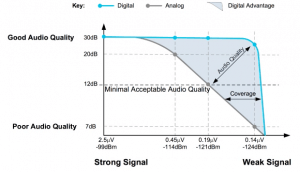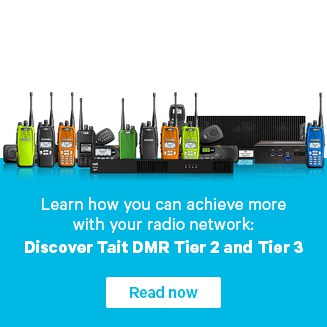Introduction to DMR
DMR Standard
Benefits of DMR
DMR offers several benefits to users, technicians, managers, and the rest of your organization.
Firstly, DMR is an ‘open’ standard and is not proprietary to a single manufacturer. This means that competition is possible between manufacturers, not only when a new system is purchased, but over the lifetime of the system. So, if you need to purchase new subscriber units there will always be multiple options and competitive pricing.
Second is Digital Audio Quality. For the end user, one of the key benefits of DMR digital radio technology is the improvement in audio quality over analog.
As shown in the graph below, an analog signal will gradually weaken and become harder to use as the distance from the site is increased. The user will experience increased amounts of ‘hiss and crackle’ until finally the received audio is completely lost in the noise.
A digital signal, however, will remain clear to the edge of coverage. DMR systems use a device called the AMBE+2™ vocoder to convert voice information into digital data. During the digitization process, the background audio noise like sirens, engines, wind etc. typically present in analog systems, is reduced.
Third is Data applications. Not only is DMR capable of transmitting voice, but the end-to-end digital nature of DMR enables data applications such as text messaging, GPS, SCADA, and telemetry. As the DMR standard also supports the transmission of IP data over the air, this allows for the easy development of standard applications. Your ability to host a wide range of data applications on your voice system will result in the greatest possible return on investment. In fact, one of the key drivers for users switching to digital is the ability to add business enhancing data services and applications to radio systems.
Fourth, DMR is a TDMA technology which offers the principle benefit of two simultaneous and independent talk paths in one single 12.5 KHz channel. For more on how TDMA works, watch lesson 2.3 in our Basic Radio Awareness course, linked below. Because you use existing licensed channels, there is an easier migration from analog to digital.
Which brings us to our fifth benefit, DMR is designed for an easy migration from analog to digital. From the start, a major design goal was that the output spectrum must fit into the existing 12.5 kHz narrowband FM channels used by legacy analog systems. As DMR uses very simple transmitters, similar to those found in analog systems, the portables and mobiles can be operated in dual mode, analog or digital mode. This makes the migration path much simpler.
Sixth, DMR has longer battery life than regular analog portables. The reason for this is greater power efficiency. One of the biggest challenges with portable devices has always been battery life.
Two-slot TDMA offers a way forward. Since a call uses only one of the two time slots, it requires only half of the transmitter’s capacity as the transmitter is idle half of the time.
Lastly, advanced control features. The DMR standard allows for the ability to use the second time slot for reverse-channel signaling.
That means instructions in the form of signals can be sent to the radio on the second time slot channel while the first channel is in a call. This capability can be used for priority call control, remote control of the transmitting radio or emergency call pre-emption and gives precise control and flexibility to the operator of a radio system. FDMA systems cannot deliver similar functionality because they are limited to one path only per spectrum channel. These are just some of the benefits of DMR.
 Radio Academy
Radio Academy






